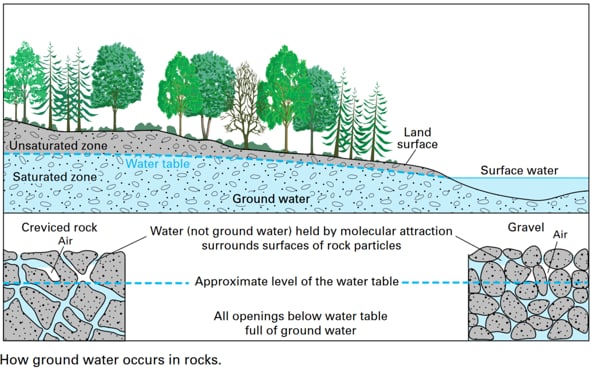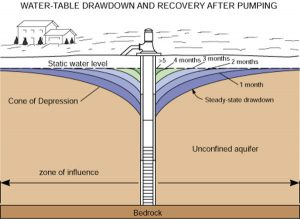The water table changes around a pumping water well based on how you use your well. Some people report that their well got dry in 5-10 years. While some private well owners use water from their wells for more than 30 years.
In this article, we are going to discuss how water table changes around pumping water well.
To understand the concept of groundwater, you need to look at the following diagram. USGS has explained the concept of changing the water table around water wells and aquifers.

Image credit : Public Domain, USGS
As you can see, the unsaturated zone does not contain any water, the saturated zone is filled with water, and once the land surface reaches the water table, surface water gets in level to the ground. Groundwater occurs in the saturated soil and rock below the water table. When people drill wells, the water starts to flow towards the well, and you can pump water out of it. The level of water changes due to pumping, and as a result, a cone of depression is formed. The following image will illustrate the process of the formation of the cone of depression.

The changes in the water table can happen due to pumping water or changes in weather, precipitation pattern, geologic changes, and human activities. If the water is withdrawn at a faster rate than the rate of replenishment, the cone of depression happens.
The impacts of drilling water can be short-lived or either long-term. If water is pumped at a faster rate and excessively, aquifers with a low water reservoir can go dry, and you will not receive water from it.
FAQ
What happens when you pump water faster than the refilling rate?
When you pump water faster than the replenishment rate, it results in a cone of depression, and the water level underneath starts to deplete. In such a case, water pressure reduces, and you have to wait for long periods for the pressure tank to get filled. If continued for a long time, this can result in your well going dry sooner than expected.
If I pump too vigorously, will my well go dry sooner than expected?
Vigorous and continuous pumping can force the wells to go dry if the water level is not too high underneath and the replenishment rate is very slow. You need to adopt safe practices of pumping water from a well and never pump more water than your well can replenish in 24 hours.
Conclusion
We should be careful while using water from a well. The Federal government does not regulate water wells and their usage, so it becomes our individual responsibility to make sure that we do not drill excessively and wastewater.
